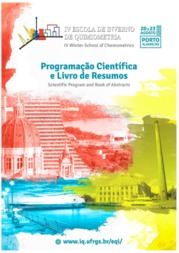Early detection and classification of Carica papaya fungi trough the analysis of volatile metabolites by gas chromatography and chemometrics.
Early detection and classification of Carica papaya fungi trough the analysis of volatile metabolites by gas chromatography and chemometrics.
Author(s): TERRA, L. R.; QUEIROZ, S. C. do N. de; TERAO, D.; FERREIRA, M. M. C.
Summary: Papaya (Carica papaya) is a fruit widely consumed in the world due to its pleasant taste and high nutritional value. Brazil stands out as one of the world?s largest producers and exporters of papaya. Concomitant to the rapid expansion of fruit production and increase in export, the phytosanitary problems have grown, such as diseases caused by post-harvest fungi, which results in enormous losses to those involved in the export1. Conventional methodologies for detection and classification of fungi are time-consuming, laborious and can only be performed after the manifestation of symptoms in fruits2. Thus, it is necessary to develop methods that allow the early diagnosis of the presence of fungi, which are fast, efficient and that permit the qualitative classification of a particular batch of fruits. As a result, it would be possible to make assertive decisions about the destination of the product batches in a timely manner. Headspace analysis is a good alternative, since the fungi produce its own volatile metabolites and during fungus contamination the fruit's metabolism changes resulting in the synthesis of new compounds or changes in the levels of the existing ones3. In this context, this work is a preliminary study and it aims the early detection and classification of fungi species isolated from papaya and the identification of the metabolites produced by these fungi based on SPME (Solid-Phase MicroExtraction), chromatographic analysis and chemometric methods. From the external border of an active growing culture of four fungal species causing stem-end rot in papaya (Alternaria alternata, Colletotrichum gloeosporioides, Fusarium palidoroseum and Lasiodiplodia theobromae), 5-mm in diameter plugs were collected and deposited in the center of Petri dishes containing potato dextrose agar (PDA) medium. The Petri dishes containing the fungi or the control (only PDA medium) were opened and placed in hermetically closed glass bottles. The system was allowed to stand for 10 min for accumulation of volatiles. Then, the headspace volatile compounds were extracted using SPME fiber with fiber coating of 65 ?m poly-dimethylsiloxane (PDMS)/divinyl benzene (DVB) for 45 min and analyzed by using a gas chromatograph coupled to a mass spectrometer using a capillary column Agilent HP-5MSUI (30 m × 0.25 mm × 0.25 ?m of film thickness). The PLS-DA method was used for the detection and classification of fungi species and the identification of the metabolites produced by each species of fungi. The developed method has proven to be a potential alternative for the detection and classification of fungi species frequently found in papaya, with a small false positive or false negative rate for each class. The results obtained are promising and it is expected to be successful in early detection and classification of fungi species in papaya.
Publication year: 2019
Types of publication: Abstract in annals or event proceedings
Unit: Embrapa Environment
Keywords: Carica Papaya, Cromatografia, Metabolites
Observation
Some of Embrapa's publications are published as ePub files. To read them, use or download one of the following free software options to your computer or mobile device. Android: Google Play Books; IOS: iBooks; Windows and Linux: Calibre.
Access other publications
Access the Agricultural Research Database (BDPA) to consult Embrapa's full library collection and records.
Visit Embrapa Bookstore to purchase books and other publications sold by Embrapa.

